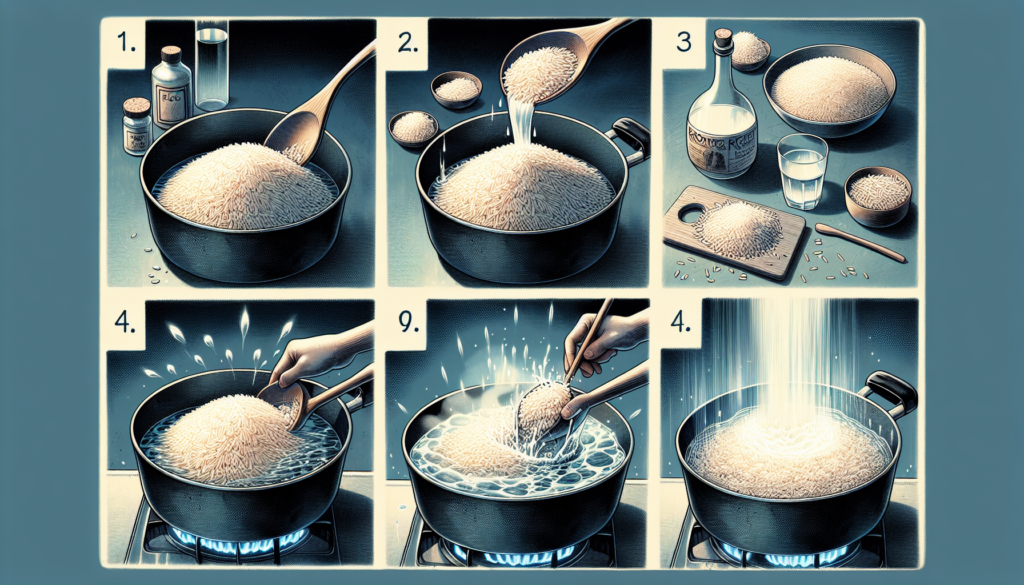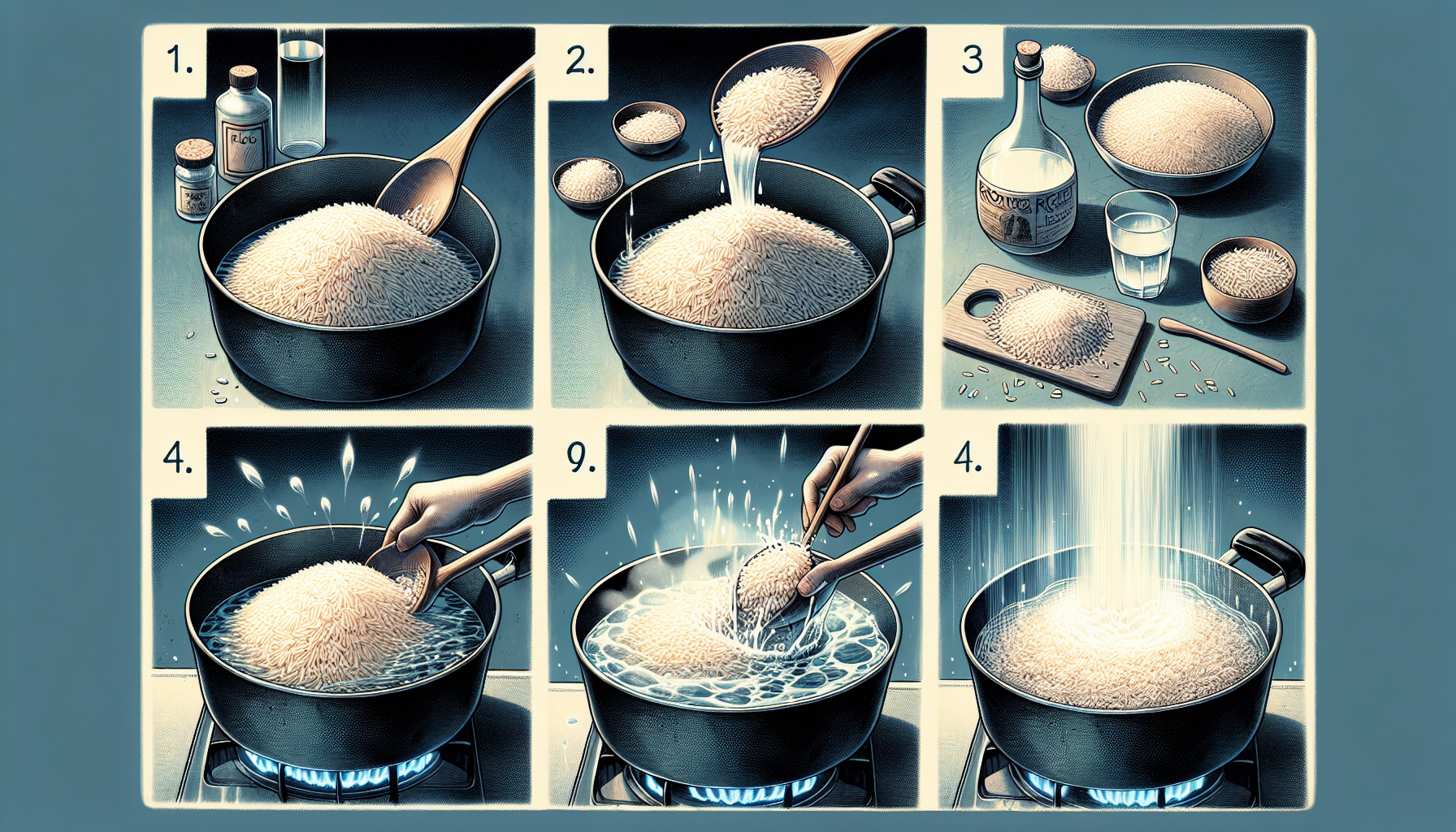You’re about to embark on a culinary journey that will leave your taste buds craving for more – learning how to cook rice step by step in just 4 easy, foolproof steps! Whether you’re a novice in the kitchen or a cooking enthusiast looking to perfect your rice game, this article will guide you through the process with clear instructions and helpful tips. Get ready to master the art of cooking rice as we break it down into bite-sized steps that will make every grain of rice perfectly fluffy and delicious!

Introduction
Cooking rice is a basic, yet essential skill that everyone should have. Whether you are making a simple side dish or a flavorful rice-based main course, knowing how to cook rice properly will elevate your culinary skills. In this article, we will guide you through the process of cooking rice, from choosing the right type to troubleshooting common issues. So let’s dive in and learn how to cook rice step by step!
Step 1: Choosing the Right Rice
Consider the Type of Rice
When it comes to cooking rice, the first step is to choose the right type. There are various types of rice available, such as long-grain, medium-grain, and short-grain. Each type has its own characteristics and is suitable for different dishes.
-
Long-grain rice: These grains are slender and have a firm texture. They stay separate and fluffy after cooking, making them perfect for dishes like pilaf or served as a side dish.
-
Medium-grain rice: This type has a slightly shorter and plumper grain compared to long-grain rice. It has a tender texture and a slightly sticky consistency, making it ideal for dishes like sushi or risotto.
-
Short-grain rice: Short-grain rice has a round and stubby shape with a higher starch content. It is often used in making sushi or any dish that requires a sticky texture.
Consider the type of dish you want to prepare and choose the appropriate rice accordingly.
Look for Quality
Once you have decided on the type of rice, it is important to look for quality. Opt for rice that is free from impurities, such as stones or insects. Additionally, check for any signs of moisture, as dampness can lead to spoilage. Choosing high-quality rice will ensure a better overall result in your cooked dish.
Determine the Quantity
To determine the quantity of rice needed, consider the number of servings you want and the appetite of your guests. As a general rule of thumb, one cup of uncooked rice typically yields about three cups of cooked rice. Adjust the quantity according to your needs, keeping in mind that rice expands during cooking.
Step 2: Preparing the Rice
Measure the Rice and Water
To achieve perfectly cooked rice, it is essential to measure the rice and water accurately. As a general guideline, use a 1:2 ratio of rice to water. For example, if you are cooking one cup of rice, you should use two cups of water. Adjust the ratio based on the type of rice and your desired consistency.
Wash the Rice
Before cooking the rice, it is crucial to wash it thoroughly to remove excess starch and any impurities. Place the rice in a fine-mesh sieve and rinse it under cold water until the water runs clear. Stir the rice gently while rinsing to ensure that all grains are washed properly.
Soak the Rice (Optional)
Soaking the rice before cooking is an optional step that can improve the texture and shorten the cooking time. It allows the grains to absorb water, resulting in fluffier rice. If you choose to soak the rice, place the rinsed rice in a bowl and cover it with water. Let it soak for about 30 minutes before proceeding with the cooking process.
Step 3: Cooking the Rice
Stovetop Method
The stovetop method is the traditional way of cooking rice and requires a pot with a tight-fitting lid. Here’s how to cook rice on the stovetop:
- Place the soaked or rinsed rice in a pot with a tight-fitting lid.
- Add the appropriate amount of water according to the ratio mentioned earlier.
- Bring the water to a boil over medium heat, stirring occasionally.
- Once boiling, reduce the heat to low, cover the pot, and let the rice simmer for the recommended cooking time. The cooking time varies depending on the type of rice you are using.
- Avoid removing the lid while the rice is cooking to prevent steam from escaping.
- After the cooking time is complete, turn off the heat and let the rice sit covered for about 5-10 minutes to allow the steam to finish cooking the rice.
- Fluff the rice gently with a fork before serving.
Rice Cooker Method
Using a rice cooker offers a convenient and foolproof way to cook rice. Here’s how to use a rice cooker:
- Add the rinsed or soaked rice to the rice cooker pot.
- Add the appropriate amount of water, following the proper rice-to-water ratio.
- Close the rice cooker lid and select the appropriate cooking setting. Most rice cookers have different options for various types of rice.
- Press the start button to begin the cooking process.
- Once the rice cooker automatically switches to the warm setting or signals that the rice is ready, let it sit for a few minutes to allow the steam to distribute evenly.
- Open the lid and fluff the rice gently with a fork before serving.
Instant Pot Method
The Instant Pot has gained popularity for its versatility in cooking various dishes, including rice. Here’s how to cook rice using an Instant Pot:
- Add the rinsed or soaked rice to the Instant Pot.
- Add the appropriate amount of water, following the recommended rice-to-water ratio.
- Close the lid and set the Instant Pot to the pressure cook or rice mode, depending on the model you have.
- Set the cooking time according to the type of rice you are using and start the cooking process.
- Once the cooking time is complete, allow the Instant Pot to naturally release the pressure for about 5-10 minutes.
- Carefully release the remaining pressure and open the lid.
- Fluff the rice gently with a fork before serving.
Step 4: Fluffing and Serving the Rice
Fluffing the Rice
Fluffing the rice is an essential step to separate the grains and avoid clumping. After the rice has cooked and rested, use a fork to gently fluff the rice by lifting and turning it. Be careful not to mash the rice while fluffing, as it can affect the texture.
Letting the Rice Rest
Allowing the rice to rest for a few minutes after cooking is crucial. This resting period helps the rice grains firm up and settle, resulting in a better texture. Keep the rice covered during this time to retain the moisture.
Serving the Rice
Once the rice is fluffed and rested, it is ready to be served. Use a serving spoon or rice paddle to portion out the rice onto individual plates or bowls. Rice pairs well with a variety of main dishes or can be enjoyed on its own as a flavorful side.
Step 5: Troubleshooting Common Issues
Rice is too mushy
If your rice turns out mushy, it may be due to using too much water or overcooking. To fix this issue, reduce the amount of water used in your next batch of rice and adjust the cooking time accordingly. Additionally, make sure to follow the recommended cooking times for the type of rice you are using.
Rice is undercooked
Undercooked rice can be a result of not adding enough water or not cooking it for the recommended time. To fix this issue, add a little bit of water to the undercooked rice and continue cooking it until the desired texture is achieved. Alternatively, you can also put the undercooked rice back on the stove or in the rice cooker to cook it for a few more minutes.
Rice is burnt
Burnt rice can be caused by using high heat or not stirring the rice properly while cooking. To prevent this issue, make sure to cook the rice on low heat and stir it occasionally to distribute the heat evenly. If a burnt smell or taste is present, it is best to discard the burnt portion and salvage the remaining rice.
Step 6: Rice Variations and Enhancements
Adding Flavor with Broth
To elevate the flavor of your rice, consider cooking it with broth instead of plain water. Vegetable, chicken, or beef broth can add a savory depth to the rice, making it a delicious accompaniment to various dishes. Simply substitute the water with an equal amount of broth and follow the cooking instructions as usual.
Mixing in Vegetables
Adding vegetables to your rice can enhance both the taste and nutritional value of the dish. Vegetables like peas, carrots, corn, or bell peppers can bring vibrant colors and flavors to your rice. Sauté the vegetables lightly before adding the rice and water to the pot, or stir them in during the cooking process for a well-incorporated dish.
Incorporating Herbs and Spices
Experimenting with herbs and spices can transform plain rice into a flavorful masterpiece. Add a pinch of herbs like thyme, rosemary, or cilantro to infuse aromatic notes into your rice. For a spicier kick, consider adding spices such as cumin, paprika, or turmeric. These additions can take your rice to the next level and complement a wide range of cuisines.
Step 7: Storage and Reheating Tips
Proper Storage
Storing cooked rice properly is essential to maintain its quality and prevent bacterial growth. Allow the rice to cool completely before transferring it to an airtight container. Store the rice in the refrigerator and consume it within 2-3 days. Avoid leaving cooked rice at room temperature for an extended period, as bacteria can multiply rapidly.
Reheating Methods
When reheating rice, it is important to do so safely while preserving its texture. Here are two common methods:
-
Stovetop: Place the desired amount of rice in a saucepan and add a small amount of water or broth to moisten it. Heat the rice over low heat, stirring occasionally, until it is heated through.
-
Microwave: Transfer the rice to a microwave-safe dish and sprinkle a little water over the top to prevent drying out. Cover the dish with a damp paper towel and microwave on high in short intervals, stirring in between, until the rice is thoroughly heated.
Step 8: Rice Recipes to Try
Classic Plain White Rice
A staple in many cuisines, plain white rice serves as a versatile side dish. Follow the cooking instructions provided earlier, using long-grain rice, to achieve fluffy and separate grains. Serve it alongside your favorite main dishes or use it as a base for stir-fries and curries.
Fried Rice
Fried rice is a delicious way to repurpose leftover rice. Heat some oil in a pan and sauté diced vegetables and proteins of your choice until cooked. Add the cooked rice and stir-fry it with soy sauce, scrambled eggs, and your favorite seasonings. Top with green onions and enjoy a flavorful and satisfying meal.
Rice Pudding
Rice pudding is a comforting dessert enjoyed by many. In a saucepan, combine cooked rice, milk, sugar, and a touch of vanilla extract. Simmer the mixture over medium-low heat, stirring occasionally, until the rice absorbs the milk and the mixture thickens. Serve warm or chilled and sprinkle with cinnamon for extra flavor.
Conclusion
Congratulations! You’ve now learned the step-by-step process of cooking rice. From choosing the right type of rice to troubleshooting common issues, you are equipped with the knowledge to prepare perfect rice every time. Remember to experiment with flavors and add your own personal touch to create unique rice dishes. So go ahead, grab your pot or rice cooker, and start cooking delicious rice that will impress your family and friends!



